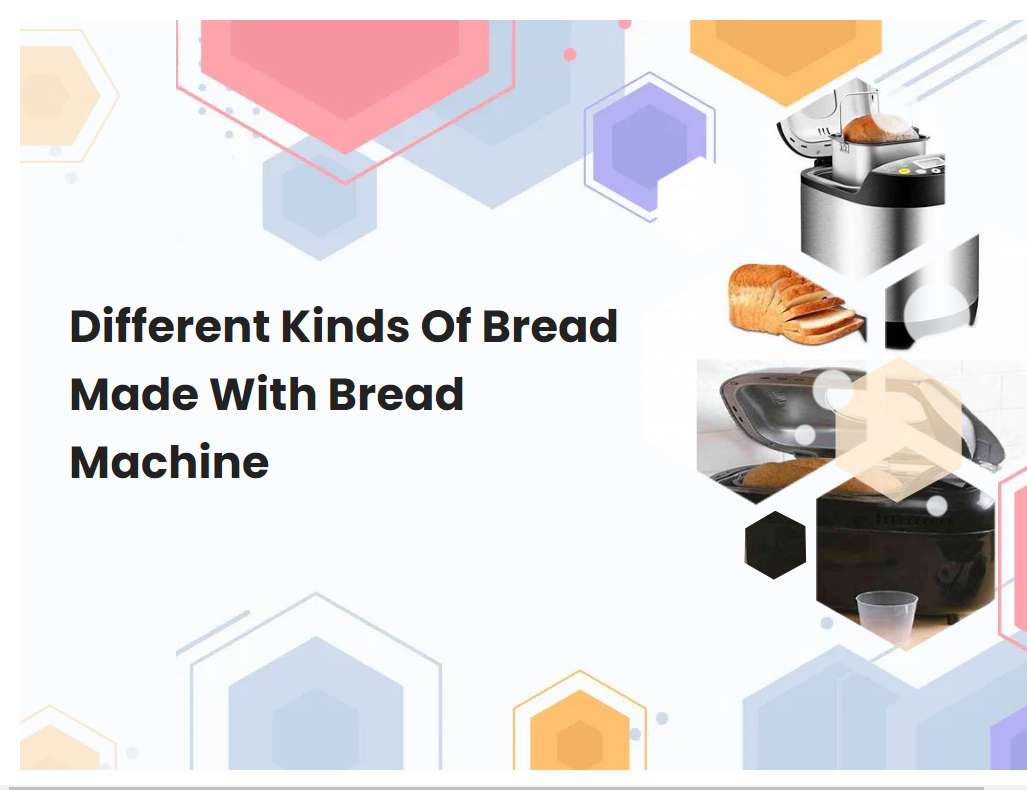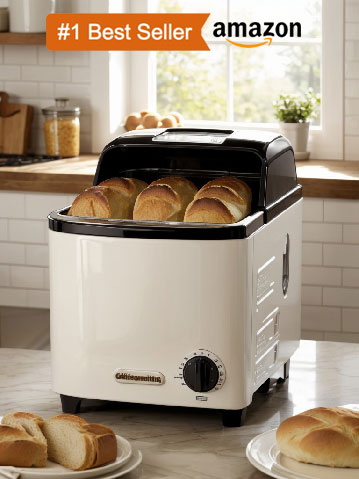Different Kinds Of Bread Made With Bread Machine
Bread machines are a great way to make fresh, delicious homemade bread. With a bread machine, you can easily and quickly make all kinds of bread, from classic white and wheat to sourdough, rye, and more. Once you have the right ingredients and recipes, you can make a wide range of different types of bread with your bread machine.

Understanding the Basics of Bread Making: You should be familiar with ingredients, measurements, and the basics of bread machine operations.
Bread making is an art and a science! To become proficient in bread making, you must understand the basics of ingredients, measurements, and the operations of a bread machine. At its core, bread is made up of flour, water, yeast, and salt.
Flour acts as the base and provides structure and nutrition to the bread. Water helps activate the yeast and binds the ingredients together. Yeast is the key ingredient that helps the dough rise, giving it its airy texture. Salt helps to give flavor and preserve the bread. To make bread, you must have the right measurements of each ingredient. Too much or too little of one ingredient can throw off the balance and make the bread dense or gooey. You must also know how to operate a bread machine properly. This includes understanding the settings, kneading process, and baking time. With some practice, you can learn to make delicious and flavorful bread from scratch!
Types of Bread: Different bread machines can make different types of bread, such as white, wheat, rye, French, Italian, and sourdough.
Bread is a staple food in many cultures, and bread machines make it easy to make delicious homemade loaves. With a bread machine, you can create a variety of types of bread, from light and fluffy white bread to hearty and flavorful rye bread. Wheat bread is also a popular choice for bread machines, as it is high in fiber and nutrients.
French bread is a classic type of bread known for its crunchy crust and airy interior, while Italian bread has a slightly denser texture and more robust flavor. Sourdough bread is unique because it uses a natural starter culture instead of commercial yeast, giving the bread a tangy flavor and a distinctive texture. No matter which type of bread you choose, a bread machine can help you make it quickly and easily.
See also: King Arthur White Bread In A Bread Machine
Dough Settings: Learn how to use the dough setting on your bread machine to make dough for other recipes such as pizza, rolls, and cinnamon buns.
Using the dough setting on a bread machine is an easy way to make dough for recipes such as pizza, rolls, and cinnamon buns. This setting will mix, knead, and rise the dough, making it ready to shape into your desired form. To use the dough setting, start by adding the liquid ingredients (such as water, milk, and oil) to the bread machine.
Then, add the dry ingredients (such as flour, sugar, yeast, and salt). Select the dough cycle, and then start the machine. Depending on the type of recipe you are making, you may need to add additional ingredients during the cycle. Once the dough has finished, you can shape it into the desired form and bake or cook it according to the recipe instructions. With the dough setting on your bread machine, you can easily make delicious homemade doughs without all the mess and hassle of kneading and rising by hand.
See also: Is Bread Machine Yeast The Same As Instant Dry Yeast
Bread Pan Size: Different bread machines accommodate different size bread pans. Check the manufacturer's instructions to determine what size bread pan you need.
When purchasing a bread machine, it is important to check the manufacturer's instructions to determine the size of the bread pan needed. Bread pans come in a range of sizes, so it is important to make sure that the pan size fits the machine. Generally, bread pans are either 1 pound or 2 pound loaves, but some machines may require different sizes.
The size of the pan may also determine the shape of the loaf. The 1 pound loaf pans are typically square, while the 2 pound loaf pans are typically oblong. Additionally, some bread pans can be used to bake other types of food such as cakes and muffins. With the right bread pan, you can make delicious, freshly baked bread with ease.
See also: How To Set Time On Zojirushi Bread Machine
Yeast: Different types of yeast can be used in bread making, including active dry yeast, rapid rise yeast, and bread machine yeast.
Bread making requires the use of yeast, a single-celled microorganism that helps to leaven dough. There are three main types of yeast used in bread making: active dry yeast, rapid rise yeast, and bread machine yeast. Active dry yeast is the most common type of yeast used in home baking.
It is composed of granules of dormant yeast that are mixed with flour and liquid to form a dough. Active dry yeast can be stored in a cool, dry place for up to a year before it is activated with warm water. Rapid rise yeast is a type of active dry yeast that works faster than traditional active dry yeast. It is easy to use with no need to dissolve it in water before adding it to the dough. Bread machine yeast is specifically designed for use in bread machines, and it is also fast-acting. This type of yeast also does not need to be dissolved in water before being added to the dough. All three types of yeast can be used in bread making, but the best results will depend on the specific recipe and the type of yeast used.
See also: How Much Gluten To Add To Wheat Bread Machine
Water Temperature: Water temperature affects the outcome of your bread. Use lukewarm water for best results.
Water temperature plays an important role in the success of a bread recipe. If the water is too cold, the dough will be stiff and difficult to work with, and the bread won't rise properly. If the water is too hot, the yeast will die and your bread won't rise at all.
The ideal temperature for bread-making is lukewarm. This means that the water should be slightly warm to the touch, but not too hot. It should feel comfortable on your skin. Using lukewarm water allows the yeast to activate and helps the dough rise properly. It also helps to mix the ingredients together more easily, resulting in a well-mixed, light and fluffy bread. When making bread, it's important to make sure that the water is at the right temperature for the best results.
See also: Wwwthrive Market Combob Mills Bread Machine Bread Mix
Kneading: Most bread machines do the kneading for you. But if you want to knead by hand, you should understand the proper techniques.
Kneading dough is an essential step in the process of making homemade bread. It helps to develop the gluten proteins in the dough and gives the finished product a chewy texture and light, airy crumb. The traditional method of kneading requires folding and pressing the dough with the heel of your hand, turning it a quarter turn, and repeating until the dough has a smooth, elastic texture.
To achieve this texture, it is important to knead the dough for an adequate amount of time. For most recipes, kneading should take up to 10 minutes. When kneading by hand, it is also important to keep the surface lightly floured to prevent the dough from sticking. Once the dough has been kneaded, it is ready to be shaped into loaves or rolls. For those who prefer not to knead by hand, most bread machines do the kneading for you.
Rising: The rising process is an important step in bread making. Knowing how to determine when the dough is ready for baking will help you achieve a better result.
The rising process is a key step in bread making that helps to achieve the desired texture and flavor. To determine when the dough is ready for baking, it is important to observe how it looks and feels. The dough should have doubled in size and will be soft, spongy, and slightly elastic to the touch.
You can also insert two fingers into the dough and if they leave an indent, the dough is ready. It is important to note that the rising time can vary between recipes and even batches, so it is important to pay close attention to the dough as it rises. If the dough rises too quickly, it can result in a dense and heavy loaf. On the other hand, if it rises too slowly, the flavor and texture may be compromised. The rising process helps to create a light and airy texture, as well as helps develop a complex flavor profile. Following the rising process as indicated in a recipe will help you achieve a better result.
Baking: Different types of bread require different baking temperatures and times. Make sure you know what your bread machine is capable of baking before you begin.
When baking bread, it is important to have a good understanding of your bread machine's capabilities before you begin. Different types of bread require different baking temperatures and times. For example, a light and airy white bread will require a lower temperature than a dense and crusty sourdough.
Similarly, a light and airy white bread will require a shorter baking time than a crusty sourdough. If you are unsure of the temperature or baking time required for the type of bread you are baking, it is best to consult the instructions included with your bread machine. Additionally, it is important to follow the instructions for your specific machine as different models may have different recommended settings. Taking the time to understand your machine's capabilities and following the instructions accurately will help ensure that your bread turns out perfectly every time.
Maintenance: Be sure to clean and maintain your bread machine regularly to ensure it continues to work properly.
Maintaining your bread machine is an essential part of keeping it in good working condition. To start, it is important to clean the outside of the machine with a damp cloth. This will help to remove any dirt and grime that has accumulated on the surface.
After that, you should unplug the machine and remove all removable parts, such as the kneading paddle, for further cleaning. Wipe these components down with warm, soapy water to remove any food particles. Once the parts have been washed and dried, reassemble them and plug the machine back in. If your machine has a removable baking pan, be sure to clean it as well, using warm, soapy water to remove any residue from previous uses. Additionally, you should periodically check the kneading paddle for signs of wear and tear, as well as inspecting the machine for any loose or broken parts. With regular maintenance and cleaning, your bread machine will continue to work properly for many years to come.





